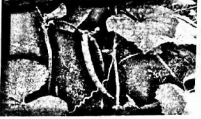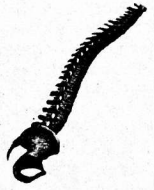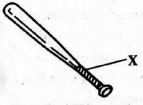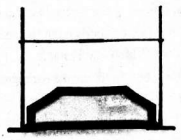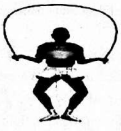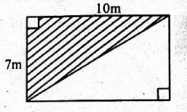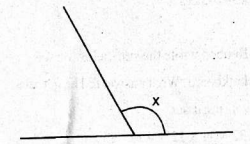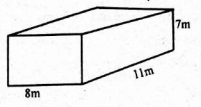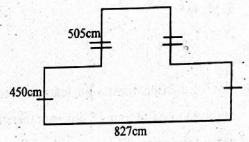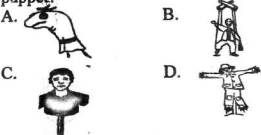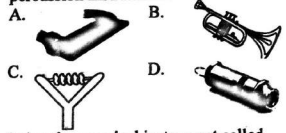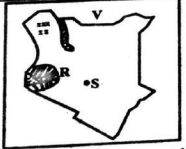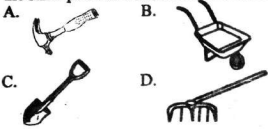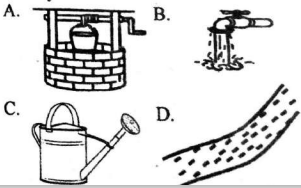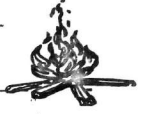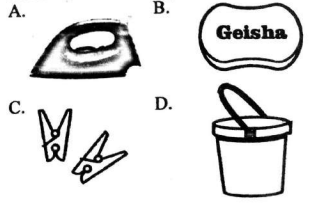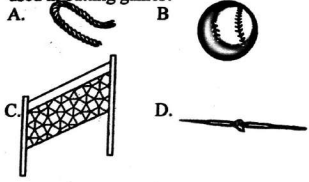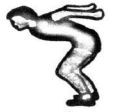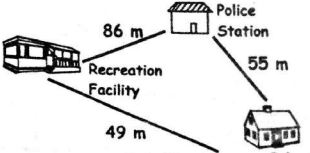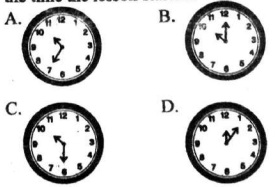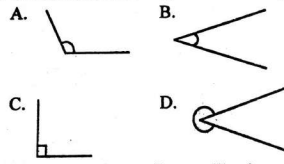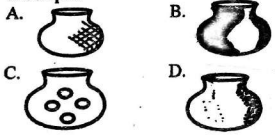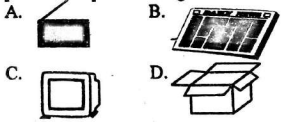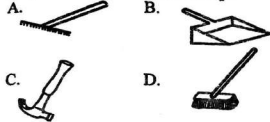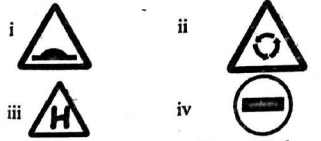Displaying items by tag: End term 1
Integrated Science Questions and Answers - Grade 6 End Term 1 Exams 2023 Set 2
QUESTIONS
- John saw the picture shown below on his way home. What type of soil erosion did he see?
- Sheet erosion
- Splash erosion
- Gulley erosion
- Rill erosion.
- Depressions in which plants are grown and are very useful where there is little rain are called
- sunken beds
- gulley beds
- tunnel beds
- potholes.
- The following are deterrents that keep animals from destroying our crops. Which one is not?
- Wire mesh
- Safe traps
- Deflectors
- Thorny fences.
- Plants with weak stems that grow along the ground are called
- vegetable plants
- creeping plants
- mangrove plants
- fruits.
- John grew the vegetable crop below in his farm.
What is the name of the vegetable crop shown above?- Spinach
- Cabbage
- Carrot
- Lentil.
- The following are tools and equipment used when caring for vegetable crops. Which one is not?
- Wheelbarrow
- Watering can
- Rake
- Jembe.
- When we start cultivating crops, we first sow the seeds in a nursery and take care of them until they are ready for transplanting. Which of the following is a step involved when taking care of nurseries?
- Mulching
- Pruning
- Harvesting
- Intercropping.
- The following are benefits of growing vegetables in the garden. Which one is not?
- It saves money on food.
- It is enjoyable doing planting activities.
- Planting vegetables minimizes waste.
- It makes us rich.
- Which one of the following is an indigenous food crop?
- Maize
- Sorghum
- Kales
- Cabbage.
- Domestic animals are kept at home for the following reasons except
- to provide security
- providing foodstuff such as milk and eggs
- to provide labour
- to babysit.
- Wild animals can be a problem as they destroy our crops and domestic animals. Which of the following is a way of dealing with them without harming them?
- Use of sound devices such as metallic plates.
- Use of poison.
- Use of traps.
- Shooting them with arrows.
- Which one of the following is a disease that we can get from being bitten or scratched by wild animals?
- Diarrhoea
- Epilepsy
- Rabies
- Malaria.
- The practice of planting crops to cover soil so that little water evaporates is called
- intercropping
- covercropping
- mulching
- shading.
- The practice of alteration of the properties of soil to improve its performance is called
- soil erosion
- soil improvement
- soil alteration
- soil organization.
- An advantage of using organic manure is that they
- can be used for a long time without affecting the soil
- cause soil erosion.
- make the soil change colour
- make the plants sweeter.
- Vertebrates are animals that
- have backbones
- do not have backbones.
- have hair or fur on their bodies
- live in the water.
- The following are flowering plants except
- bean
- algae
- orange
- passion.
- Which one of the following is not a sense organ in a human being?
- Eyes
- Tongue
- Head
- Skin
- The figure below shows a certain body muscle.
Which one of the following is not a function of the above muscles?- Protects the internal body organs.
- Helps us stand upright.
- Supports the upper body.
- Helps us to turn and twist our back.
- When we breathe in, the body takes in and uses oxygen. Which gas do we breathe out and pass as a waste product?
- Water vapour.
- Nitrogen
- Carbon monoxide
- Carbon dioxide.
- After a heavy rain season, children in Sakari area developed some cold and coughs. Which of the following is a sign and symptom of colds?
- Nose block and sore throats.
- Body aches and headache.
- Fever and sweating.
- Pain in the chest when coughing.
- The following are main measures which should be taken in the prevention of cholera. Which one is not?
- Covering cooked food to prevent flies from contaminating them.
- Washing hands with soap and water after visiting the toilet and before handling food.
- Drinking clean boiled or treated water.
- Wearing protective clothes like gumboots and water tight gloves while working in stagnant water.
- A bedbug is an external parasite. What is the meaning of an external parasite?
- Small living things that are found on the skin of human beings.
- Small living things that are found inside the body of human beings.
- Creatures found underneath the water.
- Living things that feed on dead animals.
- Grade 5 learners observed the picture below from internet.
What is the name of the parasite shown?- Round worms.
- Lice
- Hookworms.
- Tapeworm.
- The following are the things you will need to key in information in a computer. Which one is used in typing?
- The mouse
- Monitor
- A CPU
- Keyboard.
- Miriam wanted to go shopping and her mother gave her a shopping list. What is the importance of the shopping list?
- It helps save money as a person only buys what they need.
- It enables one to buy anything they like.
- It enables one to spend a lot of money.
- It makes one waste a lot of time.
- The following are factors we should consider when choosing foods from the general grocery. Which one is not?
- The type of material the packaging is made of.
- The weight of the food item.
- If the food item is popular.
- The price of the food items.
- John was advised by the doctor to take a balanced diet. What does a balanced diet consist of?
- Carbohydrates and vitamins only.
- Carbohydrates and minerals only.
- Proteins, carbohydrates and vitamins.
- Proteins and minerals only.
- The cooking method where food is placed inside a pan filled with hot oil is called
- steaming
- boiling
- grilling
- deep frying.
- The following are hygiene practices to be observed except
- brushing teeth everyday
- combing the hair regularly
- taking a bath daily and wearing clean clothes
- using a lot of deodorant when you haven'tbathed.
- The youths are advised to positively make use of digital devices. In what ways can they use digital devices positively?
- Searching for information from the internet.
- Playing video games.
- Watching scary movies.
- Using the internet to bully others.
- Malia wants to make mandazis by deep frying them. What precautions does she need to observe to avoid injury?
- Not filling the pan with oil until it is full.
- Placing the mandazis only when the oil is coiling hot.
- Throwing the mandazi in the oil and stay far away from the pan.
- Pouring water on the oil if it gets too hot.
- Most kitchen tools are made of the following materials except
- melamine
- plastics
- aluminium
- ballast.
- As Ben was cleaning dishes, he realized that he didn't have a scrubber. What material can he use instead?
- Charcoal
- Soil
- Brush
- Sponge.
- Sasha likes using accessories. Which of the following is among her accessories?
- Lips tick
- Bracelet
- Perfume
- Shampoo.
- The following are symptoms of a heart attack. Which one is not?
- Feeling exhausted.
- Chest pain.
- Irregular and rapid heartbeats.
- Diahorrea.
- Grade five learners were asked to discuss the importance of good time management. They came up with the following points. Which one is not correct? It helps us to
- finish our work on time
- do more tasks in less time
- achieve what we want faster
- become strong.
- Grade 4 learners were asked to match cleaning tools with materials used for making them. Which one of the following was not correctly matched?
- Broom: Wires, twigs, reeds.
- Dusters: Feathers or soft pieces of cloth.
- Mops: Coconut fibres or sisal fibres.
- Dust pan: Old jerry can or carton boxes.
- Communicable diseases can be passed from one person to another. Which one of the following is a communicable disease?
- Diabetes
- Coughs and colds
- Epilepsy
- High blood pressure.
- When performing a two-handed catch technique in ball games, where should the eye be facing?
- Down on the ball.
- Back of the ball.
- On the coming ball.
- Over the ball.
- A pupil performed a throw while his hips and shoulders were rotating and the throwing arm was moving downward and upward. Which pass was he performing?
- Chest pass
- Over arm pass
- Under arm pass
- Shoulder pass
- Grade 4 learners listed down places where they could play their games during free times. Which of the following places is secure?
- In the playground.
- In the dining hall.
- In the swimming pool.
- Along a busy highway.
- The following are types of passes used in soccer. Which one is not?
- Instep
- Ball of foot
- Inside of foot
- Overarm pass.
- The figure below shows a rounder's bat.
The part marked X is mostly covered by- wax
- rubber
- metal
- wool.
- Mr. Jumwa gave his grade 4 learners different ropes. Which of the following activities can they play using the rope?
- Dancing
- Hide and seek
- Skipping
- Bean bay game.
- The Warrior team have a match in the afternoon. They have to practice in the morning. Which one of the following is a cool down activity that they can perform?
- Slow dance
- Rabbit jumps
- Squat jumps
- Frog jumps.
- Abel saw the facility below in the field. What is the name of the facility shown?
- Serving area
- Landing area
- Clearing area
- Pivot point.
- The best weight for a javelin to be used by grade 6 learners should be
- 200g
- 400g
- 1kg
- 250g.
- The following are steps used in releasing a javelin.
- Throw in a straight line at the top.
- Withdraw the javelin.
- Release the javelin from the fingers.
- Stand facing forward with body turned
Which of the following is the correct order of performing the release?- (iv), (i), (ii), (iii)
- (ii), (i), (iv), (iii)
- (iii), (iv), (i), (ii)
- (iv), (ii), (iii), (i)
- A Grade 6 learner was seen performing the activity below. Which technique was he performing?
- Straddle
- Wounded duck
- Straddle cross
- Skier.
MARKING SCHEME
- D
- A
- C
- B
- D
- A
- A
- D
- B
- D
- A
- C
- B
- B
- A
- A
- B
- C
- A
- D
- A
- D
- A
- D
- D
- A
- C
- C
- D
- D
- A
- A
- D
- B
- B
- D
- B
- A
- B
- C
- B
- A
- D
- B
- C
- A
- B
- B
- D
- C
Kiswahili-Lugha Questions and Answers - Grade 6 End Term 1 Exams 2023 Set 2
Soma taarifa ifuatayo kisha ujibu maswali 1-5.
Kila mwaka shuleni kwetu huwa na sherehe za kutoa tuzo kwa walimu, wanafunzi, wafanyakazi na mtu yeyote yule aliyefanya jambo lolote jema au kitendo chochote cha manufaa shuleni. Walimu hutuzwa tuzo kutokana na juhudi zao za kufunza vizuri. Wapishi hutuzwa kwa kuandaa mlo mtamu, usafi na kupika kwa wakati bila kuchelewa. Madereva nao hutuzwa kwa kuendesha magari ya shule kwa utaratibu, kuwa na nidhamu kwa wanafunzi wala kutosababisha ajali yoyote.
Wafagiaji na wahudumu wengine kama vile mabawabu, waktubi, mahazili na mtarishi pia hutuzwa. Muhula uliopita, sisi wanafunzi tulituzwa kwa maadili, usafi, bidii na matokeo bora katika kila somo. Waliofanya vizuri katika somo la michezo na uhusiano mwema baina ya wanafunzi pia walituzwa. Mimi nilituzwa kwa kuwa bora katika Kiswahili, kuwa na nidhamu kuliko wote, kuwa safi mwaka mzima na pia nikapata tuzo ya kutumia muda wangu vizuri. Nawe pia unaweza ukapata zawadi hata zaidi yangu. Usife moyo kwa sababu ipo siku!
Maswali
- Kila mwaka shuleni kuna sherehe zipi? Za
- kutwezwa
- kutwazwa
- kutuzwa
- kutozwa.
- Wafagiaji wa shuleni ni
- wapishi
- wahazili
- waktubi
- matopasi.
- Msimulizi alipata tuzo ngapi?
- Nne
- Nyingi
- Moja
- Tano.
- Wapishi hupewa zawadi kwa kuzingatia yafuatayo isipokuwa
- kupika vyakula vitamu
- kupika kwa wakati
- kupika vyakula nadhifu
- kupika haraka.
- Ni kweli kusema kuwa
- wanafunzi walipewa zawadi za kufuzu masomoni tu
- wanafunzi walituzwa kwa kufanya vyema katika nyanja zote shuleni
- walimu walipata tuzo kwa kufunza na kuvalia vizuri
- madereva walizawadiwa kwa kuendesha magari kwa kasi.
Soma kifungu kifuatacho kisha ujibu maswali 6-10.
Katika familia au ukoo kuna utaratibu wa maisha. Kuna watu wa rika tofauti. Kuna jinsia tofauti pia. Watu wa familia huishi kwa adabu, heshima na nidhamu zinazofuata umri na jinsia. Kwa hivyo, kuna jinsi ya kusalimiana kwa kuzingatia umri na jinsia. Binadamu ni jamii yenye nidhamu na isiyotenda mambo ovyoovyo kama wanyama wafanyavyo.
Hata utaratibu wa kula hufuata kanuni na sera maalum. Huo ndio ubinadamu na ubinadamu ndio utu wa watu. Tusifanye mambo shaghalabaghala kama hayawani. Familia isiyo na utaratibu wa nidhamu si familia tena! Familia nyingine hazina salamu wala habari. Hawajiheshimu, hawaheshimu wenzao wala kuheshimiana. Hakuna babu, nyanya, mtoto, baba, mavyaa, halati wala dada. Tukiishi hivyo, yule ng'ombe mwenye mkia na pembe ataishi vipi?
- Ukoo ni kikundi cha watu wanaotokana na
- kabila moja
- dini moja
- nasaba moja
- kijiji kimoja.
- Binadamu wenye utu na ubinadamu hufanya mambo yao kwa njia gani?
- Taratibu
- Ovyoovyo
- Shaghalabaghala
- Kiholela.
- Familia au ukoo ni sawa na
- kabila
- kijiji
- jamii
- jumla.
- Ni maamkuzi yapi hutumiwa kulingana na umri?
- Habari
- Sabalheri
- Hujambo
- Cheichei.
- Halati ni
- dada ya mama
- dada ya baba
- kaka ya mama
- kaka ya baba.
Soma shairi hili kisha ujibu maswali 11-15.
Mkono wa mkulima, ni mgumu kama chuma,
Chakula cha mkulima, ni maharage na sima,
Mtazame mkulima, hatulii juma zima,
Bali huyu mkulima, ndiye mama wa uzima.
Maisha ya mkulima, ni ya shida tangu zama,
Kibanda cha mkulima, huvuja na kutetema,
Mgongo wa mkulima, daima umeinama,
Bali huyu mkulima, ndiye mama wa uzima.
Nafasi ya mkulima, mara nyingi ni ya nyuma,
Magarini mkulima, kazi yake kusimama,
Hadharani mkulima, huambiwa hana jema,
Bali huyu mkulima, ndiye mama wa uzima.
Maswali
- 'Ni mgumu kama chuma' ni fani gani ya Lugha?
- Kitendawili
- Istiara
- Methali
- Tashbihi.
- Kwa nini mgongo wa mkulima daima umeinama? Kwa sababu
- ya kazi yake
- ni mzee
- ana shida
- nyumba yake ni ndogo.
- Hili ni shairi la aina gani?
- Tathlitha
- Tarbia
- Ngonjera
- Ukulima.
- Kibwagizo cha shairi hili kina maana gani?
- Mkulima ndiye atupaye uhai.
- Kwa chakula cha mkulima tunaishi.
- Mkulima ni mama yetu.
- Mtoto wa mkulima anaitwa Uzima.
- Kuna uwezekano mkubwa wa mkulima kupanda mbegu msimu upi?
- Kiangazi
- Kipupwe
- Mchoo
- Mafuriko.
Jaza mapengo kwa majibu mwafaka.
Kila mnyama ____16____meno ____17____ ya juu na ya chini. Binadamu mtu mzima huwa na meno thelathini na ___18___ .Wanyama wote wana meno ____19____ambayo ____20____sumu kali.
| A | B | C | D | |
| 16. | ako na | yuko na | ana | anazo |
| 17. | makali | kali | mikali | kubwa |
| 18. | miwili | mbili | mawili | viwili |
| 19. | mengi | nyingi | mingi | mwingi |
| 20. | zina | yana | una | ina |
Jibu maswali kulingana na maagizo.
- Maskani ________________________ hufagiliwa.
- zetu
- mwetu
- petu
- yetu
- Baba akikasirika huwa mkali kama ______________________
- moto
- pilipili
- simba
- jua
- Andika ukubwa wa sentensi ifuatayo.
Ndoo zetu zimepasuka.- Mandoo zetu zimepasuka.
- Madoo yetu yamepasuka.
- Ndoo zetu zimepasuka.
- Mandoo yetu yamepasuka.
- Tumia kiashiria sahihi.
Ugonjwa _____________________ ni hatari.- hiyo
- ile
- huo
- iyo
- Nilipokuwa katika ziara, niliona _____________________ ya milima.
- safu
- mabunda
- msafara
- milolongo
- Baba yangu amenunua gari _____________________
- mpya
- kipya
- zipya
- jipya.
- Chagua kiwakilishi cha idadi katika sentensi ifuatayo.
Watu wengi wana gari moja lakini wachache wana pikipiki mbili.- wengi
- moja
- wachache
- mbili.
- Kati ya viwakilishi vifuatavyo, ni kipi cha nafsi ya tatu katika wingi?
- Zao
- Yeye
- Nyinyi
- Wao.
- Tambua kivumishi katika sentensi hii.
Mama huyo alitembea haraka akafika vizuri.- mama
- huyo
- haraka
- vizuri
- Kipi si kiungo cha kusafisha damu?
- Pafu
- Buki
- Figo
- Nso.
INSHA
Umepewa dakika 40 kuandika insha yako.
Andika insha ya kusisimua kuhusu mada ifuatayo;
UCHAGUZI SHULENI MWETU.
MARKING SCHEME
- C
- D
- A
- D
- B
- C
- A
- C
- D
- A
- D
- A
- B
- B
- C
- C
- A
- C
- A
- B
- D
- C
- B
- C
- A
- D
- C
- D
- B
- A
English Questions and Answers - Grade 6 End Term 1 Exams 2023 Set 2
Read the story below and answer the questions that follow.
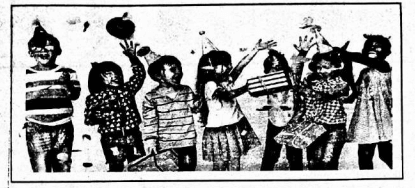
Anna was a popular girl at school. Everyone liked her very much because she always treated everyone kindly. Whenever anyone had a problem and needed help, they would go to her and she was ready to help.
One day, there was a celebration held in their school. This celebration was commonly referred to as Best Friend's Day. The teacher asked everyone to make three presents to give to three of their best friends. Everyone made presents for their friends but Anna was confused because she considered every one as her friend. When the presents were distributed, Anna did not get any present. She became really sad. Later in the evening, she told her mother what had happened. Her mother said, "your best friend is the person you give a lot of time and attention to and are willing to support you even when times are hard." She also said, "you cannot have everybody as your best friend because there will never be enough time to spend with all of them."
Anna finally understood what it means to have a best friend. She now knew that her best friend would be her mother and gave her the presents she had made.
Questions
- Why did everyone like Anna very Because she
- always treated everyone fairly
- let them copy her homework
- gave them snacks
- was rich.
- Why were the learners told to make three presents?
- The teacher was celebrating her birthday.
- It was going to be Christmas the next day.
- They were celebrating Best Friends' Day.
- They wanted to surprise their parents.
- Who was Anna's best friend according to the passage?
- Her teacher
- Everybody
- Her mother
- Nobody.
- Why can't everybody be Anna's best friend?
- There are not enough presents for everybody.
- There is never enough time to spend with everyone.
- Nobody liked her.
- It's against the law.
- Why didn't Anna get any present? She.
- did not have a best friend
- did not want any present
- was sad
- did not make any presents.
Read the following story and answer the questions that follow.
One day, there was an argument between the chameleon and hare. Chameleon was tired of hare making fun of him because of his eating habits and slow nature when he walked. To stop the argument, they decided to race to see who would win.
Hare was so confident that he would win that he started bragging to everyone about it. Tortoise was asked to be the judge. Tortoise said the first to sit on the stool at the finishing line would be the winner. The race started and when hare looked back, he did not see chameleon. He relaxed and started walking slowly while eating fruits on the side of the road. When hare reached the stool, he prepared to sit down but he heard a little voice telling him, "don't sit on me, hare, am already here." It turned out chameleon had attached himself on to hare's tail and jumped onto the stool as soon as hare turned to sit down. Hare was so surprised. The animals who had come to watch the race cheered chameleon and carried him high in the air. Hare walked away in shame.
Questions.
- Why did hare make fun of chameleon? Because
- of his eating habits and slow nature
- he was small in size
- chameleon changed colour
- he liked making fun of animals.
- Why did the hare and the chamelcon decide to race?
- For fun.
- To stop an argument.
- To win a prize.
- To see who was stronger.
- What happened when hare looked back and did not see chameleon? He
- continued to run to the finish line
- went back to look for chameleon
- lay down and slept
- relaxed and walked slowly.
- How did chameleon reach the stool before hare? He
- asked other animals to carry him
- ran all the way there
- attached himself to hare's tail
- flew there.
- What lesson do we learn from this story? We should
- not make fun of others because of their weaknesses
- always respect our elders
- always be like hare
- never be slow.
Read the following passage and answer the questions that follow.
The constitution is the fundamental principles or established rules that constitute the legal basis of a political party, organization or other type of entity and commonly determines how that entity is to be governed. When these principles are written down into a single document or set of legal documents, those documents may be said to embody a written constitution.
Constitutions concern different levels of organizations, from sovereign countries to companies and associations. A treaty that establishes an international organization is also its constitution, in that it defines how that organization is constituted. Within states, a constitution defines the principles upon which the state is based, the procedure in which laws are made and by whom. Some constitutions, also act as limiters of state power, by establishing lines which a state's rulers cannot cross, such as fundamental human rights.
The Kenyan constitution acts as a safeguard against human rights violation. The human rights contained in the constitution is the right to life, freedom of speech, association and religion, right to own land or business and several more. Without the constitution, there would be disorder and chaos. Without the constitution everyone would do as they please without regard to others. People wouldn't care whom they hurt and this world would be impossible to live in.
Questions
- What is the constitution according to the passage?
- Principals and rules that govern a party, organization or association.
- Written letters that tell us what to do
- Written document used as a learning resource.
- Rules that govern members of the family
- When the principles are written down in a single document or set of legal documents they are said to embody
- a written constitution
- the fundamental rights
- the rule of law
- the legislative council.
- _________________________ that establishes an international organization is also its constitution.
- Truce
- Name
- Constitution
- Treaty
- The Kenyan constitution acts as
- evidence of independence
- a safeguard against human rights violation.
- a way to show of how learned we are
- definite way to show how to run the country.
- Which of the following is not a human right or freedom?
- Right to life.
- Right to quality education.
- Freedom of expression and association.
- Right to own fire arms.
CLOZE TEST
For qustions 16-25, choose the correct word from the choices given to fill in the blank space.
Pollution ____16____rivers has ____17____ such a major problem to the point ____18____it is no longer safe to use water ___19___the rivers for domestic use. The water is so full of chemicals ____20____heavy metals ____21____ can cause serious ____22____and defects. This ____23____ should be ____24____ as soon _____25_____ possible.
| A | B | C | D | |
| 16. | with | of | on | by |
| 17. | be | become | is | will |
| 18. | that | then | so | such |
| 19. | on | from | for | in |
| 20. | with | but | and | by |
| 21. | which | they | by | who |
| 22. | diseases | issues | problems | matter |
| 23. | problem | issue | subject | matter |
| 24. | resolved | solved | looked at | addressed |
| 25. | as | is | it | at |
Choose the correct word to complete the sentences
- I ___________________ working on a big problem.
- am
- are
- is
- were
- You ________________________ finish your homework or get punished.
- neither.
- nor
- either
- none
- _______________________ of my friends did not attend my graduation
- Less
- Many
- Any
- None
- Mary bought an ___________________ dress.
- expensive, cotton, black
- cotton, black, expensive
- expensive, black, cotton
- cotton, expensive, black
- The bride ______________________ walked down the aisle.
- majestically
- automatically
- hurriedly
- tearfully
COMPOSITION
Below is the beginning of a story. Write and complete the story making it as interesting as you can.
As we were walking home, my brother suddenly screamed......................
MARKING SCHEME
- A
- C
- C
- B
- A
- A
- B
- D
- C
- A
- A
- A
- D
- B
- D
- B
- B
- A
- B
- C
- A
- C
- A
- D
- A
- A
- C
- B
- C
- A
Mathematics Questions and Answers - Grade 6 End Term 1 Exams 2023 Set 2
QUESTIONS
- What is 17237 written in words?
- Seventeen two three seven.
- Seventeen two hundred and thirty seven.
- Ten thousand seven thousand and two hundred and thirty.
- Seventeen thousand two hundred and thirty seven.
- A carpenter made a table 5.25m long and 2.31m wide. What is the perimeter of the table to the nearest tenths?
- 15m
- 15.1m
- 15.02m
- 15.2m
- Michelle made a square mat during a practical session. The side of the mat measured 34cm. What was the area of the mat?
- 946cm2
- 68cm2
- 1156cm2
- 136cm2
- A school has a population of 2352 pupils. If two thirds of the population were boys, how many girls were in the school?
- 784
- 1568
- 1176
- 2352
- Farmers harvested seventy tonnes of rice in one season. They later hired five lorries to transport the rice to the packaging factory. If the lorries carried equal tonnes of rice, how many tonnes did each lorry carry?
- 20t
- 14t
- 5t
- 6t.
- During a group discussion session, learners were provided with the number cards shown below.
What is the difference between the largest and the smallest 5 digit numbers that can be formed using the number cards?- 23869
- 74943
- 69832
- 76835
- Daniel was asked by his teacher to round off the product of 27 and 23 to the nearest hun- dred. What correct response would he give?
- 353
- 400
- 251
- 600
- Penina deposited H shillings in her bank account in January. In March, she deposited sh.45000 in the account. Write an algebraic expression to show the total amount of money deposited in her account.
- Sh. (H + 45000)
- Sh. (H x 45000)
- Sh. (45000 ÷ H)
- Sh. (45000 - H)
- A company bought several buses. The buses were parked in 80 rows. Each row had thirty one buses. How many buses did the company buy altogether?
- 111
- 2400
- 2480
- 2569
- A football match started at 1534hr. If the match took 90 minutes, at what time did it end in 12-hour clock system?
- 4:24p.m
- 5:04p.m
- 2:44p.m
- 4:34pm
- Grade 6 pupils were asked by their teacher to work out the sum of the H.C.F and L.C.M of 12, 24 and 48. Which of the following is the correct response?
- 24
- 12
- 60
- 36
- Liam scored 75/100 in a test. Write his score as a fraction in its simplest form.
- 3/4
- 15/20
- 0.75
- 7/10
- A shopkeepersold sixty-half litre packets of milk. How many litres did she sell on that day?
- 60 litres
- 120 litres
- 30 litres
- 60.5 litres
- Sarah drew a circle of circumference 88cm. What was the diameter of the circle?
- 44cm
- 22cm
- 176cm
- 28cm
- Helen was asked to work out the sum of 23.071, 3.932 and 10.12. What is the place of digit 7 in the sum?
- Tenths.
- Thousands
- Ones
- Tens
- In a farm, there are 27 goats and 31 sheep. If the number of dairy cows in the farm is half the sum of the goats and sheep, how many animals are in the farm altogether?
- 58
- 60
- 29
- 87
- Grade 6 pupils were discussing how to solve the sum below.
1/2 of 60 (1/2 + 1/3) − 3/4
Which of the following is the correct response?- 341/4
- 491/4
- 241/4
- 253/4
- A family consumes 21/4 litres of milk in a day. How many millilitres of milk does the family consume in a day?
- 2250ml
- 2500ml
- 270ml
- 225ml
- Asher drew the figure below. What is the area of the unshaded part?
- 70m2
- 17m2
- 35m2
- 54m2
- Grade 5 learners were measuring angles using protractors. The teacher drew the angle marked x below and asked them to measure it. What was the correct answer?
- 80°
- 120°
- 60°
- 100°
- The figure below shows a rectangular tank of height 7m, width 8m and length 11m. Work out the volume of the tank.
- 26cm3
- 706m3
- 67m3
- 616m3
22. Work out the total distance round the figure below in metres.
- 35.64m
- 27.64m
- 16.54m
- 17.82m
Below is a price list at Asali shop. Use it to answer questions 23 and 24.
| Item | Price |
| ½ litre cooking oil | Sh. 120 |
| 1kg maize flour | Sh. 110 |
| 1kg wheat flour | Sh. 140 |
| 1 litre soda | Sh. 130 |
| 35g chocolate | Sh. 25 |
| 500g salt | Sh. 30 |
| Bar soap | Sn.120 |
- Abbie bought 1 litre of cooking oil, 2kg of maize flour, 1 litre bottle of soda, 3 pieces of chocolate, 1 kg of salt and one bar of soap. How much did the items cost altogether?
- Sh.665
- Sh.905
- Sh.845
- Sh.515
- Abbie paid for the items bought in question 23 above using two-500 shilling notes. What balance did she get?
- Sh.300
- Sh.95
- Sh.485
- Sh.155
- During a group discussion, learners were required to write four - 5 digit numbers in an ascending order. Who among the following learners wrote the correct order?
- Rael - 25821, 25812, 24821, 26103
- George - 45923, 41234, 38921, 50134
- Purity - 23456, 67352, 82351, 93723
- Jayden - 89234, 78234, 64328, 43285
- A certain ceremony was attended by 378294 people. What is the total value of digit 7 in the number?
- 700
- 70000
- 70
- 700000
- To reduce the number of unemployed youths in a certain ward, the county government created 9569 job opportunities. Round off the number of jobs to the nearest thousand.
- 9000
- 9560
- 10000
- 10069
- A contractor covered a square floor of a meeting hall with 3136 square tiles. How many tiles did he place along each side of the meeting hall?
- 56
- 64
- 36
- 44
- A church-based organization donated 34678 bags of maize to an area affected by drought in the country. If each bag had 25kg, how many kilograms of maize were donated?
- 866950kgs
- 724540kgs
- 34623kgs
- 34703kgs
- Reuben wrote the sum below on the chalkboard. What answer did he get after working it out?
132 ÷ 11 x 12+ 456 − 250- 472
- 690
- 350
- 144
MARKING SCHEME
- D
- B
- C
- A
- B
- B
- D
- A
- C
- B
- C
- A
- C
- D
- C
- D
- C
- A
- C
- B
- D
- A
- C
- D
- C
- B
- C
- A
- A
- C
Creative Arts & Social Studies Questions and Answers - Grade 5 End Term 1 Exams 2023 Set 1
ART/CRAFT.
- All the following materials may be needed for thonging except a
- belt.
- leather.
- mallet.
- Knife.
- Which of the following indigenous crafts can be woven?
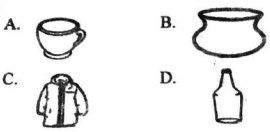
- Mundia drew a picture like the one drawn below.
The type of drawing above is called- observation drawing
- imagination drawing.
- stationary drawing.
- still life drawing.
- Komboyo wants to practice crayon etching technique. Which of the following pairs of items does he need?
- Black ink, celotape.
- Toothpick, plasticine.
- Black ink, beeswax.
- Paraffin wax, plasticine.
- Which of the following lists consists of items needed when making an expandable folder?
- Manila paper, ruler, glue.
- Pencil, needle, crayon.
- Water, scissors, cotton wool.
- Soap, eraser, glue.
- Study the diagram below.
Light and dark effects have been created using- stippling technique.
- smudge technique.
- crayon etc ing technique.
- cross hatching technique.
- When mounting artwork, what is the use of adhesives?
- Making the frame.
- Decorating the cutouts.
- Cutting out pictures.
- Sticking the cutouts.
- Clay items cannot be decorated using
- stamping.
- scratching.
- pasting.
- incising.
- Which of the following shows a glove puppet?
- Painting or. fabric can be done using
- needles.
- sponges.
- wires.
- sticks.
MUSIC.
- Which of the following French rhythms represents short sounds
- Ta-te
- Taa
- Taa - taa
- Taa-aa
- Below is an example of a percussion instrument.
The instrument above cannot be tuned by- tightening the laces.
- exposing the membrane to the heat from fire.
- adjusting the bridge.
- putting it in the sun.
- All the following members of the community can practice folk dances except
- men.
- women.
- boys.
- babies.
- A group of learners was asked to mention some items that can be used to improvise a drum.
Mercy: - clay.
Alice: - sand.
Lucy: - Log.
Joyce: - Wire.
Who among the learners mentioned a correct item?- Mercy
- Lucy
- Alice.
- Joyce.
- The East African Community Anthem is usually sung in
- mother tongue.
- English.
- Kiswahili.
- English and Kiswahili.
- Head joints and middle joints are parts of a
- guitar.
- descant recorder.
- flute.
- drum.
- Which of the following is an example of a percussion instruments.
- Below is a musical instrument called nzumari.
The instrument drawn above is played by the- Abakuria.
- Ameru
- Abagusii.
- Mijikenda.
- Which of the following hand signs represents solfa name re?
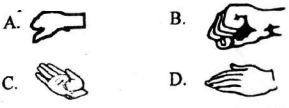
- Which of the following lines is found in the third verse of the Kenya National Anthem?
- With hearts both strong and true.
- In common bond united.
- Firm may we stand to defend.
- Justice be our shield and defender.
SOCIAL STUDIES.
- All the following are not cardinal points of a compass except
- south east.
- north west.
- south.
- south west.
- Sanaipei was asked to name an industry that deals in wheat products. Which of the following would be the correct response from Sanaipei?
- Fruit canning industry.
- Bakery industry.
- Creamery industry.
- Sawmill industry.
- The diagram below represents a type of population
The type of population represented above can be described as- straight.
- scattered.
- clustered.
- linear.
- Who among the following people depend on each other for the exchange of goods with money?
- Teachers and pupils.
- Traders and buyers.
- Police officers and thugs.
- Children in school.
- The county government gets its money from all the following sources except
- dues paid by tourists visiting the counties.
- money from land rates.
- rents from county offices.
- grants from the national government.
- Who among the following leaders in children's government in school maintains order in the classroom?
- President
- Games president
- Class representative
- Deputy president
- A situation where a child is forced to do hard work and is underpaid is called
- human rights.
- child abuse.
- child labour.
- interdependence.
- All the following are aspects of our traditional culture. Which one is not?
- The foods we eat.
- Our religions.
- The way we build our houses.
- The curriculum we follow in school.
- A cultural centre is an example of
- historic built environments.
- recreation facilities..
- physical features.
- permanent buildings.
- During rainy seasons,
- farmers harvest their farm produce.
- farmers carry out weeding in their farms.
- animals do not get sufficient pasture.
- there's no adequate water for domestic and farm uses.
- Below is a source of heat.
Which of the following fuels can best be used with the item above?- Firewood
- Charcoal
- Diesel
- paraffin
Use the map of Kenya below to answer questions 32 to 35
- The country marked V is most likely to be
- Sudan.
- Tanzania.
- Somalia.
- Ethiopia.
- The mountain marked S is called mount
- Kenya.
- Marsabit.
- Kulal.
- Longonot.
- The relief region marked R is the
- Lake basin.
- Nyika plateau.
- Rift Valley.
- Highlands.
- The main language group that lives in the area marjked xxx is
- Bantu.
- Nilotes.
- Semites.
- Cushites.
CHRISTIAN RELIGIOUS EDUCATION
- Who among the following was a dreamer according to the Bible?
- Pharaoh
- Joseph
- Jesus
- Moses
- The king who asked for wisdom from God was king
- Nebchadnezzar.
- Ahab.
- Saul.
- Solomon.
- Jesus Christ performed all the following miracles except
- changing water into wine.
- turning a stick into a snake.
- walking on water.
- Raising the dead.
- Selfishness means
- taking care of you and your friends.
- thinking about your neighbours.
- thinking only about yourself.
- helping other people whenever they need your help.
- The first book in the New Testament is called
- Genesis.
- Matthew.
- Malachi.
- Revelation.
- People of Israel were slaves in Egypt under
- Pharaoh.
- Moses.
- Pharisees.
- Joshua.
- Joseph's brothers hated him because he was
- given a coat of many colours.
- a young handsome man.
- liked most by Jacob their father.
- a close friend to Pharaoh.
- In order for Zacchaeus to see Jesus, he
- told the people in the crowd to give way.
- climbed a tree.
- used a tall ladder.
- ran ahead of the multitude.
- Abraham wanted to sacrifice his son called
- Isaac
- Samuel
- Paul
- Jonathan
- Jesus used __________________________ to teach people.
- proverbs
- stories
- riddles
- parables
- All the following are good practices for a Christian. Which one is not?
- Respecting one another.
- Helping the old.
- Abusing our enemies.
- Visiting the sick.
- The Philistine giant killed by David was called
- Goliath.
- Belshaazar.
- Pharaoh.
- Naboth.
- When Jesus raised the dead, He portrayed His power over
- diseases
- people
- death
- satan
- When the big fish vomited Jonah, he went and preached in the city of
- Tarshish.
- Capernaum.
- Caisea.
- Nineveh.
- Before Jesus calmed the storm, He was
- sleeping.
- preaching.
- fasting.
- praying.
ISLAMIC RELIGIOUS EDUCATION
- Which of the following is referred to as the opening chapter in the Qur'an?
- Al-Nasr
- Al-Walid
- Al-Kariim
- Al-Fatiha
- Surah An-Nas means the
- men.
- wind.
- dawn.
- elephants.
- I recite Al-Muawwidhatayan before I
- play.
- wake up.
- sleep.
- eat.
- All the following lessons are learnt in surah Al-Ikhlas except
- evil people have bad endings.
- Allah is one.
- Allah is unique.
- Allah controls all things.
- All the following are positive uses of social media. Which one is not?
- Listening to Qasida from a mobile phone.
- Creating dawah groups on Whatsapp.
- Sending abusive messages to those who wrong us.
- Sharing homework questions using smart phones.
- Which among the following is a vice?
- Humility
- Obedience
- Kindness
- Selfishness
- Who among the following angels is responsible for record taking?
- İsrafil
- Raqib
- Izrail
- Munkar
- Surah Al-Lahab can also be called
- Al-Walid.
- Al-Kariim.
- Al-Masad.
- An-Nas.
- The fourth swalah of the day is called
- Fajr.
- Asr.
- Dhuhr.
- Maghrib.
- When eating our food, we should
- eat it while standing to save time.
- use the right hand as advised by prophet Muhammad (SAW)
- cat from the middle of the plate.
- be sending Qur'an verses to our friends using our mobile phones.
- Praying is a way of
- securing a good place in paradise.
- speaking to Allah.
- drawing nearer and nearer to Allah.
- strengthening our faith in the religion.
- Which one of the following Islamic festivals is celebrated during childbirth?
- Milaud-un-Nabii.
- Eid-ul-Adhha.
- Aqiqah.
- Eid-ul-Fitr.
- How many pillars of Iman are there in the Muslim religion?
- Three.
- Four.
- Five.
- Six.
- Which one of the following is not an example of akhlaq?
- Feeding domestic animals.
- Protecting seedlings.
- Spending our money.
- Grazing animals.
- Which one ofthe following practices enables us observe hygiene?
- Taking wudhu
- Praying
- Helping the needy
- Fasting
MARKING SCHEME
- A
- C
- D
- C
- A
- D
- D
- C
- A
- B
- A
- C
- D
- B
- C
- B
- A
- D
- C
- B
- C
- B
- D
- B
- A
- C
- C
- D
- A
- B
- B
- D
- A
- A
- C
C.R.E
- B
- D
- B
- C
- B
- A
- C
- B
- A
- D
- C
- A
- C
- D
- A
I.R.E
- D
- A
- C
- A
- C
- D
- B
- C
- D
- B
- B
- C
- D
- C
- A
Integrated Science Activities Questions and Answers - Grade 5 End Term 1 Exams 2023 Set 1
SCIENCE AND TECHNOLOGY.
- Which of the following parts of a computer is used for selection?
- CPU
- Monitor
- Mouse
- Cables
- Aaron drew the following device on the white board.
He later asked his classmates to name it. What was their correct answer?- Keyboard
- Printer
- VDU
- Mouse.
- On which part of a computer do we read what we type?
- Monitor
- Keyboard
- CPU
- Mouse
- Which among the following substances is a gas?
- Saliva
- Dust
- Stone
- Air
- When we breathe polluted air
- we can develop breathing problems.
- we can suffer from sore eyes.
- our skin can be rashy.
- we can suffer from severe diarrhoea.
- A Grade 4 learner put a coin in a basin of water as shown below.
The coin went down into the water. We can say that the coin is a- solid.
- floater.
- material.
- sinker.
- Below is a type of teeth.
Which of the following statement is true? It- is chisel shaped.
- has cusps and ridges.
- has one root.
- is used for cutting and biting.
- During an experiment, some learners set up an experiment as shown below.
The learners could not reach the right conclusion because- they used two balloons.
- the stand they used was not very firm.
- the balloons they used were too light.
- they inflated both balloons.
- Which among the following levers has the position of the load, effort and fulcrum at the same point as a broom when at work?
- Which of the following pairs of small animals is made up of vertebrates only?
- Millipede, centipede.
- Butterfly, snake
- Snail, lizard
- Chameleon, gecko
- All plants
- make their own food.
- die.
- are green.
- move from place to place.
- In the human digestive system, saliva is produced in the
- small intestines.
- stomach.
- mouth.
- large intestines.
- A fish is like a tortoise in that they both
- have scales.
- breathe by gills.
- use their lung for breathing.
- lay fertilized eggs.
- Mawingu saw a type of cloud with the following characteristics:
- Formed low in the sky.
- Looked mountainous.
- Covered the whole sky.
The type of clouds Mawingu saw was also likely to be- a sign of rain.
- white and feathery.
- a sign of fine weather.
- having flat bottoms.
- Which one of the following is a characteristic of all animals? All animals
- make their own food.
- lay eggs.
- die.
- give birth to live young ones.
AGRICULTURE.
- Below is a domestic animal reared in Kenya
Which of the following statements is true about the animal drawn above? It- provides the farmer with quality milk.
- is used to guard our homes.
- gives two food products.
- gives only one food product.
- Which of the following is an example of vegetables?
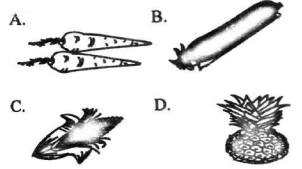
- We eat the leaves of
- Carrots.
- Onions.
- bean plants.
- maize plants.
- Which of the following is an example of cereals?
- Avocado
- Cucumber
- Spinach
- Rice
- Which of the following farm tools is needed to supply water to seedlings in a nursery bed?
- Mwikali collected the following materials in readiness to prepare compost manure:
- Ash.
- Old rags. manure.
- Kitchen refuse.
- Maize stalks.
- Farmyard
- Broken bottles.
Which pair of materials was not needed?- i, ii
- ii, vi
- ii, v
- iii, vi
- Some learners carried out an experiment like the one below to investigate a property of soil.
Which of the following statements is true about the set up above?- Soil type X is good for modelling.
- W was loam soil.
- For modelling, soil type Y was the best.
- Soil type Y was the best for farming.
- Which one of the following is a tiny seeded crop?
- Sunflower
- Maize
- Pumpkin
- Sugarcane
- Which of the following farm animals offers services only?
- Camel
- Dog
- Pig
- Chicken
- All the following are farm uses of water except
- irrigation.
- watering animals.
- washing farm tools.
- transport.
HOMESCIENCE.
- All the following foodstuffs can be bought from a general grocery except
- onions.
- milk.
- carrots.
- tomatoes.
- Makali ate ugali and spinach for his lunch. Which of the following would he add to make his meal a balanced diet?
- Avocado
- Chips
- Beans
- Kales
- All the following are protective foods. Which one is not?
- Apples
- Cabbage
- Oranges.
- Meat
- Kitchen utensils that can break easily are said to be
- brittle.
- fragile.
- vulnerable.
- weak.
- Kapano asked some of his friends to name the foods that can be fried
Wanyama: - Meat
Kwamboka: - Mandazi
Mwakazi: - Bread
Husna: - Pork
Who among then was not correct?- Wanyama
- Kwamboka
- Mwakazi
- Husna
- The diagram below shows a source of heat.
The source of heat drawn above uses- firewood.
- petrol.
- paraffin.
- charcoal.
- Machoine's school shoes are made of leather. Which of the following methods can be used to clean them daily?
- Washing
- Soaking
- Painting
- Polishing
- A dustpan is used for
- collecting rubbish.
- removing cobwebs.
- cleaning cemented floors.
- drying earthen floors.
- Which one of the following foodstuffs needs the highest standard of hygiene when preserving?
- Dry maize
- Milk
- Fruits
- Packed rice
- In laundry work, which of the following items is used in airing garments?
PHYSICAL HEALTH EDUCATION.
- Which of the following sports activities must be practised in a swimming pool?
- Front crawl.
- Back hand throw.
- Passing
- Jumping for height
- Which one of the following may be needed when improvising a ball?
- Iron sheets
- Short wires
- Long nails
- Rubber bands
- Below is a player practising a game.
The player drawn above is practising- chest pass.
- instep pass.
- kneeling overhead throw.
- under arm pass.
- Muli and her sister want to practise bounce pass. Which of the following play materials do they need? A
- ball.
- rope.
- cone.
- beanbag.
- Which of the following items below can be used in batting games?
- The type of roll demonstrated below can be applied in gymnastics.
The roll type above is called- forward roll.
- bear roll.
- backward roll.
- egg roll.
- A floater can be used by a beginner in
- athletics.
- swimming.
- frisbee.
- soccer.
- Choose a pair of harmful drugs used in the community.
- Soda and juice
- Tea and coffee
- Alcohol and cigarette.
- Paraffin and diesel.
- Study the picture below.
The sport activity demonstrated above is called- standing long jump.
- standing start.
- instep pass.
- underhand pass.
- In athletics, the point at which races end is called the
- start point.
- finish point.
- shallow end.
- landing pit.
- Single handed rim catch can be practised in
- football.
- handball.
- batting games.
- frisbee.
- Which one of the following is not an example of track events?
- Relays
- Athletics
- Run through finish
- Crouch surface
- For the improvision of a relay baton, all the following may be needed except a
- piece of wood.
- mass of cotton wool.
- manila paper.
- maize cob
- Which one of the following is not a step in hurdles?
- Take off
- Clearance
- Backstroke
- Flight
- Which one of the following is not expected in a first aid kit?
- Methylated spirit.
- Painkillers.
- A roll of bandage.
- A hammer.
MARKING SCHEME
- C
- B
- A
- D
- A
- D
- B
- D
- C
- D
- B
- C
- A
- A
- C
- D
- A
- B
- D
- C
- D
- D
- A
- B
- D
- B
- C
- D
- B
- C
- A
- D
- A
- B
- C
- A
- D
- C
- A
- B
- A
- B
- C
- A
- B
- D
- D
- B
- C
- D
Shughuli za Kiswahili Questions and Answers - Grade 5 End Term 1 Exams 2023 Set 1
Soma mazungumzo yafuatayo kisha ujibu maswali 1-5.
(Wazazi wanajadiliana na wana wao kuhusu namna na umuhimu wa kuwa na afya bora)
Baba: Mke wangu, ni siku nyingi hatujazungumza na kina Tina kuhusu masuala ya kibinafsi. (Kimya kinapita) Hebu waite tuzungumze nao.
Mama: Sawa mume wangu (anasimama dirishani akitazama nje) Tinaa!..... Ramaa!
Tina na Rama: Naam mama!
Mama: Hebu njooni humu ndani upesi (Kwa mumewe) Watoto siku hizi wakipata fursa, hawakai. Ni wao na mchezo. (Watoto wanaingia wakihema)
Baba: Wanangu, tumewaita hapa ili tuzungumze kuhusu umuhimu wa kuwa na afya bora. Ketini. (Wanaketi)
Mama: Kwanza, Tina na Rama, lazima mjue namna ya kudumisha afya bora.
Tina: Nadhani njia mojawapo ni kudumisha usafi, kula vyakula salama na kamili na kufanya mazoezi.
Baba: Vyema Tina. Tunapokuwa na afya bora, miili yetu haipatwi na magonjwa mara kwa mara.
Rama: Tena akili zetu hufanya kazi vyema na kuboresha matokeo ya shughuli zetu zikiwemo za masomo.
Mama: Si hayo tu, tunapokuwa na afya bora, sisi hupendeza na kuvutia maana miili yetu huwa na maumbo ya asili, si miili iliyokonda na kuonyesha mifupa.
Baba: Ningependa kuwa kwanzia leo kila mmoja wetu aliakikishe ubora wa afya yake kwa kutenda haya na mengine yaliyo mema.
Tina na Rama: Sawa baba.
- Baba alitaka kuzungumza na watoto wao kuhusu
- matokeo ya mtihani.
- michezo waliyokuwa wakicheza.
- masuala ya kibinafsi.
- vipindi walivyovipenda.
- Kabla hawajaitwa, Tina na Rama walikuwa wapi?
- Chumbani
- Nje wakicheza
- Wakipumzika nje
- Sebuleni
- Pendekezo la kula vyakula salama na kamili lilitolewa na
- Tina
- Rama
- mama
- baba
- Kulingana na baba, tunapokuwa na afya bora,
- matokeo ya shughuli zetu huwa mazuri.
- miili yetu huweza kupatwa na magonjwa.
- miili yetu huwa na maumbo asilia isiyokonda.
- hatupatwi na magonjwa mara kwa mara.
- Kulingana na mazungumzo haya,
- Rama na Tina hawapendi kucheza.
- hakuna haja ya kudumisha afya bora.
- wazazi waliotajwa wanawajali watoto wao.
- watu wa familia hiyo wanapenda sana kucheza.
Soma kifungu kifuatacho kisha ujibu maswali 6 hadi 9.
Amina alikuwa mwanafunzi wa Gredi ya tano katika shule ya Shaurimoyo. Mama yake alimwambia awe mwangalizi pale nyumbani alipokuwa sokoni. Amina alikuwa na kaka wawili na dada wawili. Ndugu zake Amina walikuwa watiifu.
Jumamosi moja, mama yao alienda sokoni kama kawaida. Alimwambia Amina awaelekeze ndugu zake kufanya shughuli za pale nyumbani. Amina aliwaambia dada zake waoshe vyombo na kusafisha nyumba. Kaka zake walitakiwa kuyanyunyizia maua maji na kuwashughulikia mbuzi wao. Baada ya shughuli hizo zote, watoto hao walikaa na kutulia huku wakimngoja mama yao atoke sokoni.Mama yao aliporudi, alifurahi sana kuona jinsi nyumba yao ilivyokuwa safi. Aliwapa wasichana maparachichi na wavulana miwa kwa kazi nzuri walizofanya. Wote walifurahi.
- Familia hii ina jumla ya watoto wangapi?
- Wanne
- Sits
- Watano
- Watalu
- Ikiwa kila msichana alipewa parachichi moja, mama alileta maparachichi mangapi?
- Matano
- Sita
- Manne
- Matatu
- Baada ya kumaliza kazi zote, watoto
- walikaa na kumngoja mama yao.
- walienda nje kucheza.
- waliwasha runinga na kutazama vibonzo.
- walifurahia maparachichi na miwa.
- Mama alipotoka sokoni alifurahishwa na
- utulivu wa watoto wake.
- usafi wa nyumba yao.
- bidii ya watoto wake.
- ladha ya matunda aliyoleta.
Soma kifungu kifuatacho kisha ujibu maswali 10 hadi 12.
Moto! Moto! Hii ilikuwa sauti ya kutisha kwelikweli. Ingawa nilikuwa na usingizi kiasi, nilinyanyuka kutoka kitandani kuangalia ilipotoka sauti ile. Nilichungulia dirishani. Nje, kila mmoja alikuwa akikimbia huku na kule kujaribu kuuzima moto katika nyumba ya Bi. Faya.
"Siachwi nyuma!" Nilijiambia huku nikishuka vidato. Nilipofika, kila mmoja alikuwa mbioni kuokoa hali. Ghafla, nilichukua ndoo iliyokuwa na mchanga nikampa mzee Mapunda. Naye hakusita. Aliumwaga kwenye kitovu cha moto ule. Haikutosha, Mwang'ombe akaleta ndoo nyingine huku kipusi akimimina mapipa kadhaa ya maji motoni. Baada ya muda mfupi, moto wote ukawa umezima.
- Mwandishi aliposikia sauti ya kutisha, alikuwa wapi?
- Kitandani akilala.
- Chumbani akifanya usafi.
- Nje akizima moto.
- Sebuleni akitazama runinga.
- Mwandishi aliamua kuwa haachwi nyuma kwa kuwa alikuwa
- na usingizi kiasi
- na moyo wa kusaidia.
- na ndoo yenye mchanga.
- mwenye bidii kwelikweli.
- Wakati wa ajali hii ya moto, Bi Faya alikuwa wapi?
- Sokoni
- Dukani
- Chumbani
- Hatujaelezwa
Soma kifungu kifuatacho kisha ujibu maswali 13 hadi 15.
Siku iliyofuata, mfalme simba alikuwa ameandaa mashindano yaliyotakiwa kuwahusisha wanyama wote. Hata hivyo, kunao wengine waliokuwa wameomba ruhusa kuwa wasingeshiriki. Jioni ya siku ya Ijumaa, mbweha alipita kote huku akipuliza firimbi ya kutangaza mashindano ya siku iliyofuata, mashindano ya kucheza muziki.
Wanyama waliotakiwa kushiriki walikuwa pundamilia, kinyonga na sungura. Watatu hawa walifika wakiwa wamejipodoa vilivyo. Pundamilia alikuwa amepakwa rangi nyeupe na nyeusi kwa namna ya mistari, sungura alikuwa amenyolewa mtindo wa shore na kuliacha shungi la nywele utosini huku kinyonga akiwa na mavazi mapya yaliyomkaa sawasawa.
Baada ya kila mmoja kuchukua nafasi yake na ngoma kuanza, mvua kubwa ilianza kunyesha. Kila mmoja alitimua mbio kumwacha maskini kinyonga akinyeshewa na nguo zake mpya!
- Mashindano haya yangefanyika siku ya
- Ijumaa
- Alhamisi
- Jumamosi
- Jumapili
- Wanyama wangapi walitarajiwa kushiriki katika mashindano haya?
- Watano
- Wawili
- Wanne
- Watatu
- Unadhani ni kwa nini kinyonga alibaki wenzake wakikimbia?
- Hawezi kuenda haraka.
- Alitaka kubaki pale.
- Alitaka anyeshewe.
- Alikataa kuwafuata mbio.
Soma kifungu kifuatacho. Chagua jibu lifaalo zaidi kati ya yale uliyopewa.
Siku hiyo tulikuwa tumeingoja kwa hamu na ghamu. Sote tulifika ___16___ tukiwa tayari kuabiri___17___kuelekea mjini Meremeta. Hii ilikuwa mara yangu ya ___18___ kuenda huko. Sikuwa nimewahi kuenda huko. Tuliingia ___19___ tukiwa na furaha sana. Mara dereva alitia gari ufunguo na safari
___20___.
| A | B | C | D | |
| 16. | asubuhi | shuleni | adhuhuri | usiku |
| 17. | baiskeli | basi | ndege | meli |
| 18. | moja | mwisho | tatu | kwanza |
| 19. | njiani | safari | basini | barabarani |
| 20. | ikaanza | ikaisha | ikaendelea | ukaanza |
Katika swali la 21-30, jibu swali kulingana na maagizo uliyopewa.
- Katika sentensi chura mnono aliteleza akazama, nomino ni
- mnono.
- chura.
- aliteleza.
- akazama.
- Chagua orodha ya vitenzi pekee. A
- Kiazi, bata, daftari.
- Chota, peleka, kataa.
- Sana, zaidi, polepole.
- Chini ya, kando ya, mbele ya.
- Ni gani kati ya maneno haya ni kihisishi?
- Lo!
- Katikati ya
- Mweupe
- Leo
- Kati ya orodha hizi, ni ipi ina mavazi, kike na kiume
- Kamisi, chupi, soksi.
- Koti, rinda, kofia
- Suti, soksi, tai
- Suruali, kaptura, sidiria
- Kamilisha methali:
Mwana akibebwa- usilevyelevye miguu.
- ndivyo akuavyo.
- kuzimu enda kiona.
- hutazama kisogo cha nina.
- Ni upi wingi wa sentensi ifuatayo?
Mkoba wenyewe ni huu.- Mikoba zenyewe ni hizi.
- Mikoba yenyewe ni hii.
- Mkoba zenyewe ni hizi.
- Mkoba yenyewe ni hii.
- Ni rangi gani hapa haipo katika bendera ya taifa la Kenya?
- Nyeupe
- Nyeusi
- Manjano
- Kijani
- Nomino mayai inaweza kuorodheshwa katika ngeli gani?
- U-I
- KI-VI
- LI-LI
- LI-YA
- Kitenzi chapa katika kauli ya kutendea huwa
- chapia.
- chapwa.
- chapisha.
- chapiwa.
- Kamilisha tashbihi hii
Bwana Murefu ni mfupi kama- mlingoti.
- nyundo.
- kasuku.
- nguruwe.
MARKING SCHEME
- C
- B
- A
- D
- C
- C
- D
- A
- B
- A
- B
- D
- C
- D
- A
- A
- B
- D
- C
- A
- B
- B
- A
- C
- D
- B
- C
- D
- A
- B
English Language Activities Questions and Answers - Grade 5 End Term 1 Exams 2023 Set 1
Read the following conversation and then answer questions 1 to 5.
Juma: How are you doing Saida? I'm very sorry I couldn't visit you as we agreed. How was your weekend?
Saida: I am fine Juma. Maybe next time you will make it to my place for a visit. My weekend was not very bad, I thank God. We were to visit Omari in the hospital but I couldn't make it. I'm sorry.
Juma: Ooh, that is true. Kadzo, her sister and I managed to visit Omari at Medicare hospital. How come you did not show up?
Saida: I was looking after my sick grandmother. Since there's no one at home to take care of her, I had no option.
Juma: I'm sorry Saida. What is she suffering from?
Saida: According to the doctor, she is suffering from chronic pneumonia. She also has a problem in breathing. By the way, how is Omari?
Juma: After recovery, the doctor discharged him. However he will have to take a week's time rest. I would like to see you grandmother. Let us go and take care of her.
- How many children visited Omari in 3. Medicare hospital?
- Two
- Three
- Four
- Five
- Saida could not make it to Medicare hospital because
- she wasn't feeling well.
- she was taking care of her sick mother.
- she did not want to do so.
- she was taking care of another patient at home.
- Who had a breathing problem?
- Saida's grandmother
- Saida
- Omari
- Kadzo's sister
- According to the conversation, it is true to say that Juma is
- sick.
- careless.
- caring.
- impatient.
- What was Omari suffering from according to the conversation?
- Chronic pneumonia
- Breathing problem.
- We have not been told.
Read the passage and then answer questions 6 to 9.
Rats have very sharp senses especially those of touch and hearing. They are afraid of humans and can hear you coming long before you have a chance to see them. They are loners by nature, never will they get together to defend themselves if they are threatened. Rats can also be clever. They are smart by the way they steal eggs. A rat will hold an egg firmly with all four paws lying on its back so as not to break the egg while two or three others pull it away by its tail.
- According to the passage, what can rats sense very well?
- Touching and eating
- Hearing and defending.
- Eating and defending.
- Hearing and touch.
- However smart rats are, they cannot
- help one another stealing eggs.
- defend one another.
- hear approaching human beings.
- carry away eggs.
- The method rats use to steal eggs shows their
- cleverness
- speed.
- sharp senses.
- strength.
- According to this passage, unity in rats is seen when
- sensing touch and hearing.
- surviving lonely.
- stealing eggs.
- defending each other.
Read the passage and then answer questions 10 to 12.
I was born and brought up in a liberal home by African standards. We all cooked, washed the house, clothes and dishes. It did not matter whether you were a boy or a girl. We all went to school. Everyone was allowed to pursue their own interest and their opinions were heard and respected. We were taught to appreciate our strengths and work on our weaknesses. During school holidays, we were taught lifeskills involving activities like hunting, fishing and farming. Some of us would learn pottery and basketry. Back then, life was real, unlike today where almost everything is a fiction based on technology.
- Since both boys and girls did all the chores,
- girls suffered child labour.
- boys were exposed to child labour.
- equality was observed.
- parents became very lazy.
- Which of the following is not true according to the passage?
- Human beings have strengths and weaknesses.
- The writer is not a young person.
- There is a difference between life back then and now.
- Lifeskills are not very necessary today.
- During school holidays, the writer would learn all the following except
- weaving.
- hunting
- fishing.
- farming.
Read the passage and then answer questions 13 to 15.
Dog and her puppies lived on a farm where there was a well. The mother dog told the puppies not to go near the well or play around it. One of the puppies wondered why they should not go near the well and decided to explore it. He went to the well, climbed the wall and peeped inside there. He saw his reflection and thought it was another dog. The puppy saw that the "other dog" was imitating him and got very angry. He decided to fight the dog. He jumped into the well but there was no dog there! He cried for help until the farmer came and rescued him.
- The mother dog told the puppies not to
- swim in the well.
- play around the well.
- explore the well.
- play together.
- The puppy that climbed up the wall of the well
- saw his reflection in the water.
- saw another puppy in the well.
- followed his mother's instructions.
- died in the well.
- After the puppy cried for help in the well,
- the mother dog came to his rescue.
- he died immediately
- the farmer came and helped him.
- he swam out of the well.
Read the passage below. It contains blank spaces numbered 16 to 20. For each blank space, select the best alternative from the choices given.
Wambua and his family are farmers. They live in a big farm house. One day, Wambua went as usual to milk his cow. He had cleaned the cowshed the ___16___ night and left Maziwa, the ___17___cow to rest. When he woke up the following morning. Maziwa had a difficulty in breathing. She also did not welcome Wambua with her usual ___18___ Wambua called a ____19___ doctor who said Maziwa had a thorn in morning. her mouth which pricked her ___20___.
| A | B | C | D | |
| 16. | following | past | last | previous |
| 17. | daily | diary | dairy | daring |
| 18. | meow! | moo! | woof! | mee! |
| 19. | veterinary | witch | family | animal |
| 20. | woof | skin | gum | horn |
For questions 21 to 23, select the best article to complete the sentences.
- My cousin studies at _______________________ university.
- an
- the
- a
- then
- It was ______________________ honour to be warmly welcomed.
- the
- a
- at
- an
- ________________________ sun was shining bright in the morning.
- A
- An
- As
- The
In questions 24 to 26, select the best alternatives to fill the blank spaces.
- Kombora ____________________ take his son to school tomorrow.
- shall
- has
- will
- had
- Mumo and I _____________________ be practising in the field.
- would
- shall
- were
- could
- The porridge in the jug ___________________ not cold.
- has
- will
- hadn'
- is
For questions 27 to 30, choose adjectives in the given sentences
- My cat's fur is very soft.
- fur
- cat's
- soft
- very
- The blanket Ongeti bought was red.
- red
- blanket
- Ongeti
- bought
- Kafupi is the tallest boy in our class.
- class
- boy
- tallest
- Kafupi
- The food Tina prepared was delicious.
- Tina
- food
- delicious
- prepared
MARKING SCHEME
- B
- D
- A
- C
- C
- D
- B
- A
- C
- C
- D
- A
- B
- A
- C
- D
- C
- B
- A
- C
- B
- D
- D
- C
- B
- D
- C
- A
- C
- C
Mathematics Activities Questions and Answers - Grade 5 End Term 1 Exams 2023 Set 1
QUESTIONS
- In Babalao county, the total population of Grade 5 learners is 24 761. What is this number in words?
- Two thousand, four hundred and seventy six thousand and one.
- Two thousand, four hundred and seventy thousand and sixty one.
- Twenty four thousand, seven hundred and sixty one.
- Twenty four thousand, six hundred and seventy one.
- A teacher wrote the number 86 430 on the board. He later asked Nyang'au to state the total value of the underlined digit. What was Nyang'au's correct answer?
- 600
- 6000
- 60 000
- 60
- Grade five East has thirty five learners, Grade 5 North has 34 learners and Grade 5 south has 33 learners. What is the total number of Grade 5 learners to the nearest hundred?
- 102
- 200
- 202
- 100
- A number is divisible with 5 if the last digit is
- 2
- 0
- 0 or 5
- 5
- 48 farmers transplanted 16 seedlings each. How many seedlings were transplanted altogether?
- 768
- 64
- 668
- 54
- During Tuyu's birthday ceremony, 9 of his classmates attended. If 5 of them were boys, what part of the classmates were girls?
- 5/9
- 1/9
- 4/9
- 9/10
- There were 56 players to be ferried to a tournament. A motorbike rider carried 3 players per trip. How many players were carried in the last trip?
- 5
- 2
- 7
- 1
- Out of 2 642 sacks of maize harvested, 1 349 were sold and the rest kept in the store. How many sack were kept in the store?
- 1 293
- 3 991
- 1 283
- 3 891
- In the number 13.46, which digit is in the ones place value?
- 1
- 3
- 4
- 6
- A member of County Assembly shared 99 bales of maize flour equally to 9 families. How many bales did each family receive?
- 90
- 891
- 10
- 11
Use the map below to answer the following questions.
- Mawingu rode his bike from the police station to the school, went back to the police station and finally rode to the recreation facility. What distance did he cover?
- 110 m
- 141 m
- 196 m
- 282 m
- How far is it from police station to the recreation facility than from the school to the recreation facility?
- 141 m
- 29 m
- 31 m
- 33 m
Study the figure below and use it to answer the following questions.
- How many columns are in the figure above?
- 5
- 10
- 50
- 40
- How many rows are there?
- 10
- 40
- 50
- 5
- What is the area of the figure above?
- 10 square units.
- 55 square units.
- 50 square units.
- 40 square units.
- Wanyama's goat is 63 kg while his sheep is 69 kg. What is the total mass of the animals?
- 172 kg
- 132 kg
- 162 kg
- 122 kg
- Study the diagrams below.
How many jugs of water does Maria need to fill the sufuria?- 18
- 10
- 40
- 20
- Which of the following consists of wants only?
- Maize, beans
- Radio, television
- Banana, cabbage
- Rice, blouse
- A Mathematics lesson ended at 10.35 am. If the lesson started 2100 seconds ago, which of the following clockfaces shows the time the lesson started?
- Ali had a 90 kg sack of maize. He sold 20 kg and took 15 kg home for consumption and stored the rest. How many kilograms were stored?
- 65 kg
- 125 kg
- 35 kg
- 55 kg
- Some learners were asked to name the properties of a rectangle.
Yuda: - It has four right angles.
Pilato: - All sides are equal and parallel.
Kaisari: - It is a four sided figure.
Herode: - All the interior angles add up to 360°
Who among the learners was wrong?- Herode
- Pilato
- Kaisari
- Yuda
- Eight Grade 5 learners shared r exercise books equally. If one book remained, which of the following expressions can be used to find the total number of the books before sharing?
- (r+8) + 1
- 1 − (8xr)
- 8 − (1xr)
- (8+r) +1
- Kabambe was given 15 balloons to share with with his friends. p of them were white while 6 of them were blue. How many ballons were white?
- 21
- 20
- 9
- 10
- Which of the following is an obtuse angle
- Mr Karanga drew a diagram like the one drawn below
The diagran Mr. Karanga drew represents?- Clockwise turn.
- Quarter turn.
- Anti clockwise turn.
- Full turn.
- Which of the following is the next shape in the pattern below?
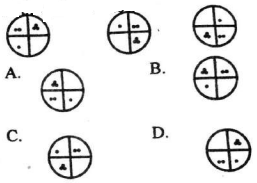
The table below shows the types of foods enjoyed by learners at Afyabora restaurant
| Type of food | No. of learners |
| Chips, fish | 15 |
| Ugali, matumbo | 8 |
| Rice, stew | 11 |
| Matoke, greens | 9 |
| Chapati, beans | 10 |
- What was the total number of learners who enjoyed chapati, beans and ugali, matumbo?
- 28
- 18
- 10
- 8
- Which food was least liked?
- Chips, fish
- Ugali, matumbo
- Rice, stew
- Matoke, greens
- How many more learners took chips, fish than those who took rice, stew?
- 26
- 15
- 4
- 11
- In total how many learners enjoyed different foods in Afyabora restaurant
- 73
- 43
- 63
- 53
MARKING SCHEME
- C
- B
- D
- C
- A
- C
- B
- A
- B
- D
- C
- C
- B
- D
- C
- B
- B
- B
- B
- D
- B
- A
- C
- A
- C
- A
- B
- B
- C
- D
Creative Arts & Social Studies Questions and Answers - Grade 4 End Term 1 Exams 2023 Set 1
ART & CRAFT.
- Which of the following shows smudge technique?
- Kimani wants to practise weaving on a dowel loom. Which of the following materials can be use?
- Wires
- Plasticine
- Thread
- Cotton wool
- A table mat can be made using
- modelling technique.
- folding technique.
- basketry technique.
- weaving technique.
- Study the diagram below
The type of drawing shown above is called- still life drawing.
- imagination drawing.
- observation drawing.
- nutritive drawing.
- Which one of the following is a source of pictures for photomontage?
- The diagram below show a play item.
The part labelled Y is made of- papers.
- threads.
- wires.
- stones.
- All the following can be used when making a doll. Which one cannot?
- Clothes
- Cotton wool
- Rubber bands
- Cement
- A Grade 4 Art and Craft teacher asked some pupils to name the best weather to play with a propeller.
Tim - rainy
Kim - windy
Sam - calm
Val - cloudy
Who among the pupils was correct?- Kim
- Tim
- Sam
- Val
- Marangi drew a picture and wanted to paint it red. Which of the following items would he use?
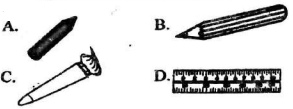
- Embedding and incising technique can both be used to decorate
- wood items.
- clay items.
- paper items.
- fabric.
MUSIC
- Which of the following shows a string instrument?
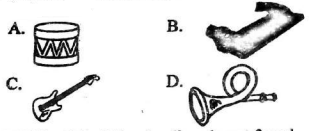
- Which of the following lines is not found in the first verse of the Kenya National Anthem?
- Justice be our shield and defender.
- O God of all creation.
- Plenty be found within our borders.
- Let one and all arise.
- Which of the following types of songs is sung for babies to sleep?
- Patriotic songs
- Lullabies
- Sacred songs
- Gospel songs
- Which of the following animals produces a "moo" sound?
- Sheep
- Cow
- Cat
- Dog
- When performing singing games, we must always observe
- gender.
- weather.
- time.
- safety.
- Which one of the following is a percussion instrument?
- Flute
- Trumpet
- Drum
- Guitar
- Which of the following body parts cannot be used for dancing?
- Shoulders
- Legs
- Head
- Teeth
- Lavalava wanted to record his string instrument as he played it. Which of the following devices was necessary for the task?
- Magazine
- Newspaper
- Smartphone
- Television
- Which one of the following can be used to improvise a drum?
- Sand
- Used jerrycan
- Clay
- Cotton wool
- String instruments can be played by
- blowing
- hitting
- plucking
- shaking
SOCIAL STUDIES.
- Which of the following is an example of built environments?
- Museum
- Valley
- Plateau
- Forest
- Which one of the following is a cardinal point of the compass?
- South east
- North
- North west
- South west
- The diagram below represents compass directions.
*
The direction labelled P is called- north west
- south west
- south east
- north east
- The diagram below shows a source of heat.
The source of heat drawn above uses- firewood.
- charcoal.
- gas.
- petrol.
- At home, water can be used for
- keeping fish.
- travelling.
- cooling machine.
- cooking.
- All the following items can be used to keep a market place clean except
- Animals in distress are those that are
- dead.
- sick.
- eating.
- active.
- Which of the following types of wastes cannot burn in a rubbish pit?
- Paper wastes
- Dry leaves
- Glass materials
- Old rags
- Which of the following can be used to collect rain water?
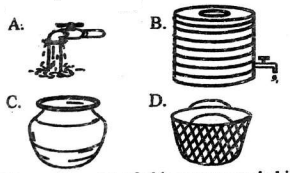
- Mauzo has a lot of old newspapers in his store. What should he do with them?
- Sell them
- Burn them
- Keep them
- Read them
- The following are road signs.
Which of the above signs shows that there is a hospital around?- iv
- ii
- i
- iii
- Wastes collected in the school compound should be disposed in the
- dustpan.
- rubbish pit.
- bucket.
- dust bin.
- Animals can be relieved from distress by
- hanging name tags on their ears.
- exposing them to some work.
- isolating the male ones from female ones.
- treating them in a veterinary.
- Below is a way of protecting plants.
The plant protection method shown above is called- fencing
- pruning
- weeding
- thinning.
- Which of the following is a harmful cultural practice?
- Child naming celebration.
- Circumcision.
- Female genital mutilation.
- Singing harvest songs.
CHRISTIAN RELIGIOUS EDUCATION
- Who among the following is not a member of the extended family?
- Uncle
- Cousin
- Aunt
- Brother
- All of us were made to look like our
- parents.
- teachers.
- God.
- friends.
- Which one is not the work of the Holy Spirit in a Christian's life? The Holy Spirit helps us to
- be unkind.
- do good things.
- live in peace.
- love others.
- All the following are fruit of the Holym Spirit except
- love.
- joy.
- faith.
- peace.
- On the day of Pentecost,
- believers spoke in different languages.
- a voice was heard from above.
- darkness covered the land.
- the disciples were drunk in the morning.
- While reciting the Lord's prayer,
- we should be walking around.
- there must be darkness.
- we should have our Bibles at hand.
- we must adopt a posture of prayer.
- Lala and her brother were given homework to do. Instead of doing the work, Lela's brother started playing. As Christians how best should Lela correct her brother?
- Do his work for him.
- Tell him to finish the work then play later
- Funish him.
- Call the teacher and tell him what he is doing.
- Which Christian value did Ananias and Sapphira leck?
- Trust
- Obedience
- Responsibility
- Honesty
- In the story of the unforgiving servant, which punishment did the king give the unforgiving servant? He
- threw him in a den of lions.
- threw him in a furnace of fire.
- jailed him.
- sent him out of the empire.
- We should always ____________________________ God for wonderfully and fearfully creating us.
- hate
- thank
- accuse
- blame
- The miracle of Jesus walking on water encourages Christians to have strong
- feet.
- courage.
- faith.
- obedience.
- How many loaves of bread had the boy with two fish?
- 7
- 10
- 3
- 5
- The good Samaritan helped a man who was beaten up by
- poachers.
- killers.
- robbers.
- jews.
- Whose daughter did Jesus raise from the dead
- Jairus'
- Lazarus'
- Jethro's
- Pharaoh's
- The home town of Jesus was
- Bethlehem.
- Golgotha.
- Capernaum.
- Nazareth.
ISLAMIC RELIGIOUS EDUCATION
- The word Qul as used in Surah Ikhlas means
- read.
- go.
- pray.
- say.
- Which of the following surah means the men?
- An-Nas
- Al-Fatiha
- Al-Ikhlas
- Al-Falaq
- Allah has no parent or children is a lesson from surah
- Al-Lahab
- Al-Ikhlas
- Al-Kauthar
- Al-Maun
- Who among the following was Allah's prophet?
- Raqib
- Jibril
- Mikail
- Issa
- Which one of the following can be sung in Islamic ceremonies?
- Lullabies
- Taarab
- Qaswida
- Hymns
- Which of the following God-given bounties do we use for sight?
- Eyes
- Heart
- Ears
- Hands
- Allah gave Nabii Daud a holy book called
- Quran
- Zabur
- Injil
- Taurat
- Prophet Muhammad (SAW) was known by all to be
- humble.
- unkind.
- rude.
- jealous.
- Qadar means Allah's
- ability
- power
- wisdom
- people
- ______________________ is an Islamic festival.
- Mashujaa
- Easter
- Eid
- Christmass
- Muslims fast in the holy month of
- Dhulhijja.
- Shabaan.
- Rabiulawwal.
- Ramadhan.
- Taking good care of family property shows
- fear.
- responsibility.
- carelessness.
- kindness.
- Alhamdulillah is said when a fellow Muslim
- sneezes.
- dies.
- falls.
- coughs.
- The last swalah of the day is called
- Isha.
- Fajr.
- Asr.
- Maghrib.
- According to prophet's hadith, we use our right feet when entering a
- bus.
- masjid.
- classroom.
- building.
MARKING SCHEME
- B
- C
- D
- A
- B
- A
- D
- A
- C
- B
- C
- D
- B
- B
- D
- C
- D
- C
- B
- C
- A
- D
- D
- C
- D
- C
- B
- C
- B
- A
- D
- B
- D
- A
- C
CRE
- D
- C
- A
- C
- A
- D
- B
- D
- C
- B
- C
- D
- C
- A
- D
IRE
- D
- A
- B
- D
- C
- A
- D
- A
- B
- C
- D
- B
- A
- A
- B



